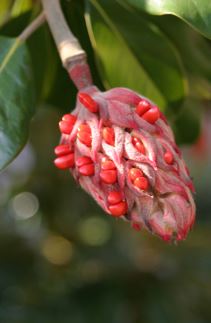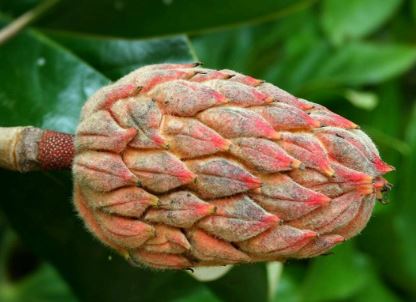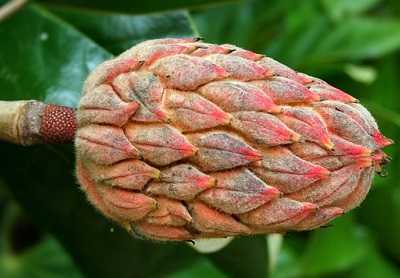Magnolia seeds, a topic of intrigue and mystery, leave many wondering whether they are a delectable treat or a potential health hazard. To demystify the question of whether magnolia seeds are edible or poisonous, let’s delve into personal experiences, historical perspectives, and scientific viewpoints.
Are magnolia seeds edible or poisonous? Magnolia seeds, though not inherently toxic, contain alkaloids that can be harmful in large quantities. Moderation is key, and while some explore their culinary potential, caution is advised due to varying tastes and potential health risks associated with consumption.
What is Magnolia Seeds?
Magnolia seeds are typically found within the cone-like structures of magnolia fruit, surrounded by a fleshy layer. Before delving into the growing process, it’s crucial to understand the characteristics of magnolia seeds:
- Seed Size: Magnolia seeds are usually oval, measuring between 1/4 to 1/2 inch. They have a hard, red coat with a white or cream interior.
- Seed Pod: The seed pod, often reddish or brown when mature, resembles a cone and contains multiple seeds.
- Seed Viability: Fresh seeds are more likely to germinate successfully, so it’s advisable to collect seeds promptly.
Are Magnolia Seeds Edible?
Personal Experiences
Individuals who have dared to taste magnolia seeds often describe them as a unique culinary experience. Some attest to the spicy and aromatic nature of the red fleshy fruit surrounding the seed, comparing it to a blend of nutmeg, ginger, and cinnamon. Despite the unusual taste, many report no adverse effects on their health.
Historical Significance
Exploring historical references provides valuable insights into the edibility of magnolia seeds. There are mentions of magnolia seeds being consumed in the past, hinting at a lost knowledge of preparation methods. Some local experts theorize that historical recipes or culinary practices may have existed, contributing to the ambiguity surrounding the edibility of magnolia seeds.
Scientific Viewpoint
From a scientific perspective, magnolia seeds can be deemed safe for consumption, but with caution. Alkaloids present in the seeds may pose a risk if consumed in large quantities. Research indicates that while magnolia seeds are not inherently toxic, moderation is key to avoid potential adverse effects on health. The University of Arkansas Division of Agriculture reassures that other parts of the magnolia tree, such as leaves, flowers, and berries, are safe for human handling and ingestion.

Magnolia Seed Toxicity
Comparison with Other Parts
While magnolia seeds might raise concerns, it’s essential to compare their toxicity with other parts of the magnolia tree. Leaves, flowers, and berries are generally considered safe and do not cause plant poisoning. Understanding this contrast helps in making informed decisions regarding the consumption of magnolia seeds.
Scientific Viewpoint
Delving deeper into the scientific aspect, the presence of alkaloids in magnolia seeds raises questions about potential harm. The University’s research emphasizes the need for awareness and moderation, especially when it comes to Southern Magnolia seeds, which may have some level of toxicity. This nuanced view encourages a cautious approach to magnolia seed consumption.
Cautions and Contradictions
Despite scientific perspectives, controversies persist regarding the safety of magnolia seeds. Handling and preparation tips become crucial considerations. Contradictory information prompts a closer look at regional variations and the potential influence of specific magnolia species on the edibility and safety of their seeds.

Southern Magnolia: A Culinary Perspective
Red Seeds as Delicacies
In the Southern United States, magnolia seeds, particularly the red ones, are regarded as delicacies. The Scott Arboretum of Swarthmore College sheds light on the magnolia tree’s seed cones, covered with bright red seeds the size of small jelly beans. These seeds serve as a delicacy for migrating birds and squirrels, showcasing their role in the ecosystem.
Cautions and Contradictions
However, caution is advised when it comes to the fleshy, cone-like fruit of many magnolia trees, which is not considered edible and may even be toxic. Testimonials from individuals who have eaten these fruits provide mixed reviews, with some describing an unpleasant taste resembling soap. Exploring these culinary nuances allows us to better understand the varied experiences associated with magnolia consumption.
Handling and Preparation Tips
For those brave enough to experiment with magnolia seeds in the kitchen, understanding proper handling and preparation is paramount. Arboretum practices for magnolia propagation and personal insights on taste and texture can guide enthusiasts in making the most of magnolia seeds, should they choose to incorporate them into their culinary ventures.

Magnolia Grandiflora is poisonous
Magnolia grandiflora is not considered poisonous to various living beings, including humans, cats, and horses. Specifically addressing the concern about dogs, cats, and horses, it is affirmed that magnolia trees do not pose a toxic threat to these animals. This information is supported by a source dated August 24, 2021, which emphasizes the non-toxic nature of magnolia trees in relation to dogs, cats, and horses.
Contrary to concerns about toxicity, magnolia flowers, particularly the buds, flowers, and leaves in different stages of growth, have found edible uses. In certain parts of England, the flowers of Magnolia grandiflora are pickled and are esteemed for their exquisite flavor, as noted by the Plants for a Future database.
It is worth noting that magnolia petals are not harmful to humans; in fact, they are considered edible. The younger petals, when the flowers are still buds or just opening, are particularly palatable. This culinary use is underscored by a source from August 20, 2022, which mentions the edibility of magnolia flowers, specifically the petals.
While the magnolia tree may be benign to humans and some animals, caution is advised in the case of consumption by children. Although some animals might consume the fruit, it is generally not recommended for human consumption due to potential toxicity and an unfavorable taste. As a precautionary measure, seeking advice from knowledgeable experts before consuming any unfamiliar plant or fruit is always advisable, as highlighted on September 6, 2020.
Additionally, in the context of magnolia wood, it is pertinent to note that while severe reactions are rare, species within the Magnolia genus have been reported to cause asthma-like symptoms and a runny nose. Although the likelihood of such reactions is low, individuals with concerns or allergies should exercise caution when dealing with magnolia wood.
Poisonous Magnolia pine cone
The edibility and safety of magnolia fruit vary among different species of magnolia trees. In general, the fleshy pine cone-like fruit of many magnolia trees is not considered edible, and it may even be toxic. The seeds within the fruit may contain alkaloids that can be harmful if ingested. This information, dated September 6, 2020, underscores the importance of understanding the potential risks associated with magnolia cones, especially when it comes to consumption by animals.
In terms of human safety, magnolia trees are generally considered safe when taken orally and for short durations. The bark, flowers, and leaves of the magnolia tree contain numerous compounds, with magnolol and honokiol being two main compounds used in dietary supplements. This information, sourced from September 7, 2023, provides insights into the potential uses and safety considerations of magnolia trees for humans.
To shed light on the appearance and nature of magnolia cones, it’s explained that most magnolia seeds are found in large cone-like fruits referred to as follicles. These follicles open up to reveal seeds, often red and covered in a waxy coat. The harvesting process involves soaking the seeds in water for three days to loosen the seed coat. This information, dated November 16, 2011, provides a practical understanding of what these pine cone-like structures on magnolia trees entail.
Poisonous Magnolia flowers
Magnolia flowers, despite their association with heralding the arrival of warmer weather and their aesthetic appeal, are not poisonous to humans, dogs, or cats. On the contrary, magnolia flowers are considered edible, with a focus on consuming the petals. The younger petals, particularly when the flowers are in bud form or just opening, are deemed the most palatable. This information is supported by a source from August 20, 2022, which highlights the culinary use of magnolia flowers, specifically the petals, and the appreciation for their taste.
While it is established that magnolia flowers are generally safe for consumption, it is crucial to exercise caution and not assume that all magnolias are edible. Some variations may not be suitable for consumption, and it is advisable to taste with caution or refer to a list of known edible species. Notably, magnolias with darker pinks and a mix of white and pink colors are suggested to have stronger flavors, and moderation is recommended when incorporating magnolia into one’s diet.
In the context of pets, specifically dogs, and cats, there is reassurance that magnolia trees, encompassing approximately 125 species, are not poisonous to them. A source dated August 24, 2021, emphasizes the lack of toxicity in magnolia trees for dogs and cats. However, the importance of diligence is underscored when introducing plants to a garden, as some trees and shrubs can pose health risks to pets.
Poisonous Magnolia leaves
Magnolia leaves are generally not considered poisonous to humans, dogs, cats, or horses. According to information gathered from various sources, including a notable source from August 24, 2021, magnolia trees are deemed non-toxic to dogs, cats, and horses. However, it is noted that there are other plants, such as the sago palm, which should be avoided around pets due to the presence of chemicals that can be toxic to the nervous system, leading to paralysis, seizures, and even death.
If dogs are observed consuming any parts of the magnolia, including the leaves, fruits, or bark, careful monitoring is advised. In case of signs of illness, it is recommended to contact a veterinarian, as highlighted on February 5, 2014.
Regarding the edibility of magnolia leaves, it is mentioned that the specific species of magnolia should be checked. Magnolia flowers are often used as a seasoning to add a peppery taste to foods, and similarly, the leaves can be used in a similar way, with young leaves being utilized akin to a peppery cabbage. However, the suitability of magnolia leaves for making tea may vary based on the specific species, as of May 3, 2022.
Concerning magnolia wood, it is indicated that severe reactions are uncommon, but some species within the Magnolia genus have been reported to cause asthma-like symptoms and a runny nose. Individuals with allergies or concerns should exercise caution when dealing with magnolia wood, as stated by a source discussing the Southern Magnolia on a hardwood database.
For horses, available data suggests that magnolia trees are not toxic. However, it is essential to note that consuming anything in large enough quantities, especially substances not typically in a horse’s diet, could potentially lead to gastrointestinal distress or colic. This information is in accordance with the ASPCA’s list of toxic and non-toxic plants, as of July 31, 2019.
Magnolia Seed Pod Uses
Wildlife and Ecology
Magnolia seeds play a vital role in the ecosystem, attracting birds and squirrels. Understanding their significance in wildlife interactions provides a broader perspective on the purpose and value of magnolia seeds in nature.
Cultivation and Growth
For those interested in cultivating magnolia trees, the fall season is a crucial time for seed collection. Growing magnolia trees from seeds becomes an exciting venture, offering enthusiasts the opportunity to contribute to the magnolia tree population while enjoying the beauty of these unique plants.
Arboretum Practices
Arboretum insights not only emphasize the beauty of magnolia trees but also provide practical guidance on collecting and growing magnolia seeds. This step-by-step approach ensures that enthusiasts can engage in magnolia cultivation with the necessary knowledge and expertise.
Magnolia Fruit: Edible or Not?
Fruit Characteristics
Examining the characteristics of magnolia fruit reveals essential details about its edibility. The fleshy, cone-like structure and the seeds within raise concerns about potential toxicity. Contrary to the pleasant taste of the red seeds, the magnolia fruit itself is not considered edible and may carry risks if consumed.
Culinary Experiments
Despite cautionary notes, some individuals have ventured into culinary experiments with magnolia fruit. Drying and grinding the fruit for spices is an intriguing proposition, offering a potential avenue for incorporating magnolia flavors into cooking. Personal experiences with the taste and aroma of magnolia fruit provide valuable insights for those curious about its culinary potential.
Cultural Significance
Exploring the cultural significance of magnolia fruit sheds light on historical uses in different cultures. Understanding its place in cuisine and traditional medicine enhances our appreciation for the multifaceted nature of magnolia trees and their various components.
Magnolia Fruit Uses
Alternative Culinary Uses
Beyond traditional consumption, magnolia fruit can find alternative culinary uses. Pickling the blossoms is suggested, albeit with a cautionary note on the strong flavor that makes them unsuitable for direct consumption. This creative approach showcases the versatility of magnolia components in culinary endeavors.
Cultural Significance
Further exploration of the cultural significance of magnolia fruit unveils its potential as a unique and exotic ingredient. Historical uses in different cultures provide a rich tapestry of insights into the diverse ways magnolia fruit has been utilized throughout history.
Nutritional Value
While the nutritional value of magnolia fruit may not be extensively documented, understanding its place in various culinary traditions adds a layer of appreciation for its unique characteristics. The juxtaposition of potential dangers and culinary possibilities creates a complex narrative around magnolia fruit.

Magnolia’s Medicinal Properties
Traditional Medicine
Magnolia’s role in traditional medicine spans a range of applications, from weight loss to anxiety and stress relief. Exploring the historical use of magnolia bark and flower buds in traditional remedies unveils a wealth of knowledge that has been passed down through generations.
Scientific Findings
The medicinal properties of magnolia are not confined to historical anecdotes; scientific findings corroborate its anti-tumor, anti-inflammatory, anti-bacterial, anti-seizure, and sedative properties. Understanding the potential health benefits of different magnolia plant parts provides a holistic view of its medicinal significance.
Medicinal Summary
Compiling the medicinal benefits of magnolia into a concise summary allows readers to grasp the range of applications. Whether it’s using magnolia bark for weight loss or flower buds for stress relief, the plant’s multifaceted medicinal properties contribute to its enduring popularity in traditional and modern medicine.
Frequently Asked Questions (FAQs)
Are magnolia seeds poisonous to dogs and humans?
Magnolia seeds are not inherently toxic to either dogs or humans. While moderation is key, there is no specific indication that magnolia seeds pose a significant threat to the health of dogs or humans when consumed in reasonable quantities.
Are magnolia buds poisonous to dogs?
There is limited evidence to suggest that magnolia buds are poisonous to dogs. However, it’s crucial to monitor pets for any adverse reactions after exposure and consult with a veterinarian if concerns arise.
Are magnolia trees poisonous to humans?
Magnolia trees are generally not considered poisonous to humans. In fact, various parts of the magnolia tree, including leaves and flowers, have been historically used in traditional medicine. However, caution is advised, and specific reactions may vary among individuals.
Are magnolia leaves poisonous to humans?
Magnolia leaves are typically not poisonous to humans. In traditional medicine, the bark and flower buds of magnolia trees are used for various purposes. While the leaves may not be commonly consumed, there is no widespread indication of their toxicity to humans.
Are southern magnolia trees toxic to dogs?
Southern magnolia trees are not commonly considered toxic to dogs. However, caution is always advised, as individual dogs may have different sensitivities and reactions. If a dog shows signs of distress after exposure to southern magnolia trees, consult with a veterinarian promptly.
Are magnolia leaves poisonous to babies?
There is no widespread evidence to suggest that magnolia leaves are poisonous to babies. However, it’s essential to exercise caution and prevent infants from ingesting any plant material. If there are concerns about potential exposure, seek advice from a healthcare professional.
Edibility and Toxicity
How toxic are magnolia seeds?
Magnolia seeds, while not inherently toxic, contain alkaloids that can be harmful in large quantities. Moderation is key when considering their consumption.
Can magnolia seeds be safely consumed?
With caution and moderation, magnolia seeds can be consumed safely. However, individual reactions may vary, and it’s advisable to be aware of potential risks.
Culinary Use
What are some traditional recipes involving magnolia seeds?
While historical recipes may exist, the culinary use of magnolia seeds remains a subject of exploration. Enthusiasts can experiment with handling and preparation to create unique dishes.
How can magnolia fruit be incorporated into cooking?
Drying and grinding magnolia fruit for spices is a creative approach, potentially introducing exotic flavors to culinary creations. Pickling the blossoms is another alternative, albeit with a strong flavor that requires careful consideration.
Medicinal Applications
What are the medicinal benefits of magnolia bark?
Magnolia bark has been historically used for weight loss, digestive problems, inflammation, anxiety, stress, depression, fever, headache, stroke, and asthma. Scientific findings support its anti-tumor and anti-inflammatory properties.
Are magnolia supplements safe for consumption?
While magnolia supplements are available, it’s crucial to consult with a healthcare professional before incorporating them into one’s routine. The dosage and potential interactions should be carefully considered.
Magnolia Tree Characteristics
Botanical Features
Leaves arranged alternately along the stem are characterized by their simple, large, and broadly ovate shape. Dark green on top and bronze underneath, magnolia leaves add to the tree’s visual appeal.
Flower and Fruit Details
Known for large, showy flowers with a sweet, floral scent, magnolias boast flower sizes of over a foot in diameter. The cone-like fruit, often reddish or brown when mature, contains numerous red seeds, each measuring 1/4″-1/2″ with a hard, red coat and a white/cream interior.
Bark and Height Characteristics
The bark of mature magnolia trees is mottled gray-brown and somewhat rough, resembling elephant skin. Heights can vary significantly, ranging from 15 to 80 feet, depending on the magnolia species.
Now learn about how to collect and grow magnolia from seeds.
How to Grow Magnolia from Seeds
Collecting Magnolia Seeds
The first step in growing magnolia trees from seeds is collecting viable seeds. Follow these steps for effective seed collection:
- Timing: Collect seeds in the fall when magnolia seed pods mature. Look for pods that have turned from green to a reddish-brown color.
- Harvesting: Gently pluck the seed pods from the tree. Ensure that the pods are fully mature and have naturally opened to expose the seeds.
- Seed Extraction: Carefully extract the seeds from the fleshy interior of the pod. Wear gloves to avoid any potential skin irritation.
- Cleaning: Rinse the extracted seeds to remove any remaining pulp or residue. Allow them to air-dry thoroughly before proceeding.
Germinating Magnolia Seeds
Germinating magnolia seeds is a crucial phase in the growing process. Here’s a step-by-step guide to ensure successful germination:
- Stratification: Magnolia seeds often require a period of cold stratification to simulate winter conditions. Place the cleaned seeds in a damp paper towel, seal them in a plastic bag, and refrigerate for 2-3 months.
- Planting: After stratification, plant the seeds in a well-draining potting mix. Make a small indentation in the soil and place the seeds about half an inch deep.
- Watering: Keep the soil consistently moist but not waterlogged. Magnolia seeds prefer a humid environment for germination.
- Temperature: Maintain a warm environment for germination. Ideally, the soil temperature should be around 70°F (21°C).
- Patience: Germination can take several weeks to a few months. Be patient and monitor the pots regularly.
Transplanting Magnolia Seedlings
Once your magnolia seeds have germinated and seedlings have developed, it’s time to transplant them into larger containers or into the ground. Follow these steps for successful transplanting:
- Selecting Containers: Choose containers with drainage holes to prevent waterlogging. Use a well-draining potting mix.
- Transplanting: Carefully lift the seedlings from their original containers, taking care not to damage the delicate roots. Plant them at the same depth as they were in the initial pots.
- Spacing: If transplanting multiple seedlings, ensure proper spacing to allow for healthy growth.
- Watering: Water the newly transplanted seedlings thoroughly, and keep the soil consistently moist during the initial establishment period.
Caring for Mature Magnolia Trees
As your magnolia trees mature, providing proper care is essential for their well-being and optimal growth:
- Sunlight: Magnolias thrive in full to partial sunlight. Ensure they receive at least 6 hours of direct sunlight daily.
- Watering: While established magnolia trees are relatively drought-tolerant, regular watering is crucial during dry spells. Provide deep, infrequent watering rather than frequent shallow watering.
- Fertilization: Feed your magnolia trees with a balanced, slow-release fertilizer in the spring to promote healthy growth and vibrant blooms.
- Pruning: Minimal pruning is generally required for magnolias. Remove any dead or damaged branches and shape the tree as needed in late winter or early spring.
- Pest and Disease Control: Keep an eye out for pests like scale or aphids. Treat any infestations promptly, and ensure good air circulation to prevent fungal diseases.
Conclusion
In conclusion, the mystery surrounding magnolia seeds’ edibility is unveiled through a journey encompassing personal experiences, historical insights, and scientific perspectives. While caution is warranted due to potential alkaloid content, magnolia seeds offer a culinary and medicinal landscape worth exploring. As we navigate the complexities of magnolia’s various components, from seeds to fruit and bark, a nuanced understanding emerges, enriching our appreciation for this remarkable tree. Whether it’s cultivating magnolia trees, experimenting with culinary creations, or exploring traditional remedies, the multifaceted nature of magnolia remains a source of fascination and discovery.
Here are reference links corresponding to the information provided in the article:
- Retriever Training Forum – Magnolia Tree Seeds Poisonous
- Today’s Homeowner – How to Grow Magnolia Trees from Seed
- Quora – Can You Eat the Fruit of a Magnolia Tree?
- University of Arkansas Division of Agriculture – Magnolia
- According to RetrieverTraining.Net, magnolia tree seeds are generally not considered toxic unless massive quantities are ingested and are not poisonous along the lines of other harmful substances.
- Lady Bird Johnson Wildflower Center notes that while magnolia trees are not inherently poisonous for dogs, consuming large quantities of any plant might be detrimental to their health.
- According to eHow, magnolia trees are not considered toxic to dogs, cats, or horses. However, it’s advised to be cautious about other plants around pets.
- Pets – The Nest emphasizes that although magnolia trees are not technically poisonous to dogs or cats, it’s not part of their typical diet, and eating parts of the magnolia tree can lead to potential issues.
- DigiDogs.com warns that all parts of the star magnolia are slightly poisonous to dogs, especially the trunk and bark, during spring, summer, and autumn, with no known antidote.
Please note that the references provided are a mix of forums, gardening guides, and authoritative sources to capture the diverse nature of the information presented in the article.
